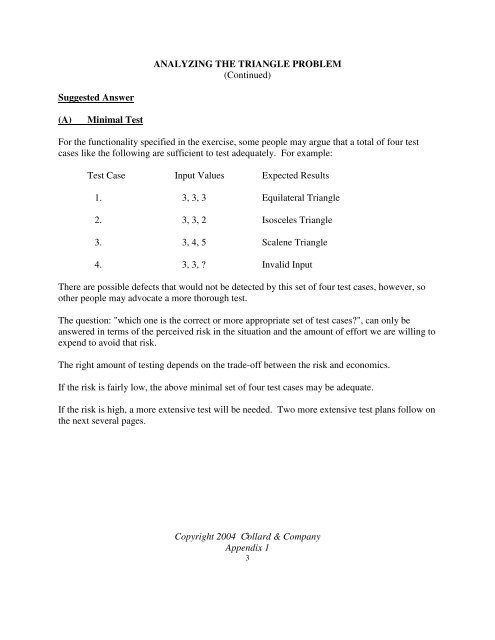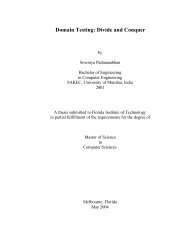appendix 1. analyzing the triangle problem - Testing Education
appendix 1. analyzing the triangle problem - Testing Education
appendix 1. analyzing the triangle problem - Testing Education
You also want an ePaper? Increase the reach of your titles
YUMPU automatically turns print PDFs into web optimized ePapers that Google loves.
Suggested Answer<br />
(A) Minimal Test<br />
ANALYZING THE TRIANGLE PROBLEM<br />
(Continued)<br />
For <strong>the</strong> functionality specified in <strong>the</strong> exercise, some people may argue that a total of four test<br />
cases like <strong>the</strong> following are sufficient to test adequately. For example:<br />
Test Case Input Values Expected Results<br />
<strong>1.</strong> 3, 3, 3 Equilateral Triangle<br />
2. 3, 3, 2 Isosceles Triangle<br />
3. 3, 4, 5 Scalene Triangle<br />
4. 3, 3, ? Invalid Input<br />
There are possible defects that would not be detected by this set of four test cases, however, so<br />
o<strong>the</strong>r people may advocate a more thorough test.<br />
The question: "which one is <strong>the</strong> correct or more appropriate set of test cases?", can only be<br />
answered in terms of <strong>the</strong> perceived risk in <strong>the</strong> situation and <strong>the</strong> amount of effort we are willing to<br />
expend to avoid that risk.<br />
The right amount of testing depends on <strong>the</strong> trade-off between <strong>the</strong> risk and economics.<br />
If <strong>the</strong> risk is fairly low, <strong>the</strong> above minimal set of four test cases may be adequate.<br />
If <strong>the</strong> risk is high, a more extensive test will be needed. Two more extensive test plans follow on<br />
<strong>the</strong> next several pages.<br />
Copyright 2004 Collard 3 & Company<br />
Appendix 1<br />
3








